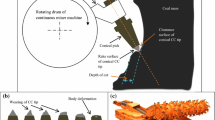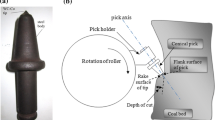Abstract
Wear phenomena of cemented carbide (94 wt.% WC, 6 wt.% Co) tip of conical picks have been observed by field emission scanning electron microscopy, energy dispersive x-ray spectroscopy (EDS), and x-ray diffraction analysis (XRD). The conical pick is one type of the cutters which are used to excavate soft structure like coal. It has a cone-shaped abrasive part made of cemented carbide (CC). The picks, under study, have been used for coal mining in an underground mine through a continuous miner machine. During the critical analysis of four picks, wear mechanisms are categorized into four parts, such as, cracks, cavity formation in WC grains, grinding effect, and roughness of WC surface. Through a careful examination, the cracking mechanism has been further divided into three parts. They are cracks with overlapping surfaces, crack on a large surface of CC, and cracks in WC grains. In addition, the severe crushing and tearing of WC grains have also been clearly examined. The possible causes of each wear phenomenon have been explained comprehensively. Crushing and corrosion are the two wearing processes which have severely deteriorated the condition of the CC. Corrosion has been easily identified by observing a number of pores and triangular notches in the WC surface. The oxidation of WC grains due to corrosion has been established by EDS and XRD.














Similar content being viewed by others
Abbreviations
- W:
-
Tungsten
- Co:
-
Cobalt
- WC:
-
Tungsten carbide
- CC:
-
Cemented carbide
- FESEM:
-
Field emission scanning electron microscopy
- EDS:
-
Energy dispersive x-ray spectroscopy
- SDD:
-
Silicon drift detectors
- nm:
-
Nano-meter
- kV:
-
Kilo-volt
- V:
-
Volt
- pA:
-
Pico-ampere
- nA:
-
Nano-ampere
- BSE:
-
Back scattered electron
- STEM:
-
Scanning transmission electron microscopy
- H:
-
Hydrogen
- S:
-
Sulfur
- O:
-
Oxygen
- Fe:
-
Iron
- Cu:
-
Copper
- Cl:
-
Chlorine
References
P. Kenny and S.N. Johnson, The Effect of Wear on the Performance of Mineral-Cutting Tools, Colliery Guard., 1976, 224(6), p 246–251
S. Dewangan, S. Chattopadhyaya, and S. Hloch, Wear Assessment of Conical Pick Used in Coal Cutting Operation, Rock Mech. Rock Eng., 2014, doi:10.1007/s00603-014-0680-z
12CM Series Continuous Miner Product Review; www.joyglobal.com
A. Mukhopadhyay and B. Basu, Recent Developments on WC-Based Bulk Composites, J. Mater. Sci., 2011, 46, p 571–589
G.S. Upadhyaya, Materials Science of Cemented Carbides—An Overview, Mater. Des., 2001, 22, p 483–489
G. Aylward and T. Friendly, SI Chemical Data, P. Storer, Ed, Wiley, Sydney, 1994
R.K. Rajput, A Text Book of Manufacturing Technology: (Manufacturing Processes), Firewall Media, 2007, p. 407
H. Tulhoff, Carbides. Metal like Carbides of Industrial Importance, Ullmann’s Encyclopedia of Industrial Chemistry, Wiley, 2000.
N. Bilgin, H. Copur, and C. Balci, Mechanical Excavation in Mining and Civil Industries, CRC Press, 2013, p. 103-123
J. Larsen-Basse, Binder Extrusion in Sliding Wear of WC-Co Alloys, Wear, 1985, 105, p 247–256
K. Jia and T.E. Fischer, Abrasion Resistance of Nanostructured and Conventional Cemented Carbides, Wear, 1996, 200, p 206–214
J. Pirso, S. Letunovits, and M. Viljus, Friction and Wear Behaviour of Cemented Carbides, Wear, 2004, 257, p 257–265
Y.V. Milman, S. Luyckx, and I.T. Northrop, Influence of Temperature, Grain Size and Cobalt Content on the Hardness of WC-Co Alloys, Int. J. Refract. Met. Hard Mater, 1999, 17, p 39–44
C. Ding, Y. Zhao, Y. Ding et al., The Study on the Grinding Performance of the Different Grain Carbide, Diam. Abras. Eng., 2009, 173(5), p 67–70 ([in Chinese])
K.J.A. Brookes, Hardmetals and Other Hard Materials, International Carbide Data, 1992
G.A. Wood, Quality Control in the Hard Metal Industry, Powder Metall., 1970, 13, p 338–368
W.M. Daoush, K.H. Lee, H.S. Park, and S.H. Hong, Effect of Liquid Phase Composition on the Microstructure and Properties of (W, Ti) C Cemented Carbide Cutting Tools, Int. J. Refract. Metal Hard Mater., 2009, 27, p 83–89
G.H. Lee and S. Kang, Sintering of Nano-Sized WC-Co Powder Produced by a Gas Reduction-Carburization Process, J. Alloy. Compd., 2006, 419, p 281–289
B.G. Fish, G.A. Guppy, and J.T. Ruben, Abrasive Wear Effects in Rotary Rock Drilling, Trans. Inst. Min. Met., 1959, 68, p 357–383
U. Beste, T. Hartzell, H. Engqvist, and N. Axén, Surface Damage on Cemented Carbide Rock Drill Buttons, Wear, 2001, 249, p 324–329
P. Kindermann, P. Schlund, H.G. Sockel, M. Herr, W. Heinrich, K. Görting, and U. Schleinkofer, High-Temperature Fatigue of Cemented Carbides Under Cyclic Loads, Int. J. Refract. Metal Hard Mater., 1999, 17, p 55–68
M. Lagerquist, A Study of the Thermal Fatigue Crack Propagation in WC-Co Cemented Carbide, Powder Metall., 1975, 18, p 71–88
T.A. Stolarski, Tribology in Machine Design, Butterworth-Heinemann, Oxford, 2000
B. Maidl, L. Schmid, W. Ritz and M. Herrenknecht, Hard Rock Tunnel Boring Machines, Ernst & Sohn, Berlin, 2008
K.H. ZumGahr, Microstructure and wear of materials, Elsevier, Amsterdam, 1987
U. Beste and S. Jacobson, Friction Between a Cemented Carbide Rock Drill Button and Different Rock Types, Wear, 2002, 253, p 1219–1221
U. Beste and S. Jacobson, Micro Scale Hardness Distribution of Rock Types Related to Rock Drill Wear, Wear, 2003, 254, p 1147–1154
J. Larsen-Basse, Effect Of Composition, Microstructure, and Service Conditions on the Wear of Cemented Carbides, J. Met., 1983, 35, p 35–42
K.G. Stjernberg, U. Fisher, and N.I. Hugoson, Wear Mechanisms due to Different Rock Drilling Conditions, Powder Metall., 1975, 18, p 89–106
J. Larsen-Basse, C.M. Perrott, and P.M. Robinson, Abrasive Wear of Tungsten Carbide-Cobalt Composites. I. Rotary Drilling Tests, Mater. Sci. Eng., 1974, 13, p 83–91
K.J. Swick, G.W. Stachowiak, and A.W. Batchelor, Mechanism of Wear Of Rotary-Percussive Drilling Bits and the Effect of Rock Type on wear, Tribol. Int., 1992, 25, p 83–88
J. Larsen-Basse, Wear of Hard-Metals in Rock Drilling: A Survey of the Literature, Powder Metall., 1973, 16(13), p 1–32
S. Olovsjo, R. Johanson, F. Falsafi, U. Bexell, and M. Olsson, Surface Failure and Wear of Cemented Carbide Rock Drill Buttons—The Importance of Sample Preparation and Optimized Microscopy Settings, Wear, 2013, 302, p 1546–1554
A.L. Echtenkamp, Combating Corrosion/Wear with the Hard Carbide Alloys, Proc. ASLE/Asme Lubrication Conf. ( Minneapolis), 1978
A.M. Human and H.E. Exner, Electrochemical Behaviour of Tungsten-Carbide Hardmetals, Mater. Sci. Eng. A, 1996, 209, p 180–191
C.N. Machio, D.S. Konadu, J.H. Potgieter, S. Potgieter-Vermaak, and J.V. Merwe, Corrosion of WC-VC-Co Hardmetals in Neutral Chloride Containing Media, ISRN Corros., 2013, doi: 10.1155/2013/506759
G. Singh, A Survey of Corrosivity of Underground Mine Waters from Indian Coal Mines. Int J. Mine Water, 2006, International Mine Water Association 2006: www.imwa.info.
H. Engqvist, U. Beste, and N. Axen, The Influence of pH on Sliding Wear of WC-Based Materials, Int. J. Refract. Metal Hard Mater., 2000, 18, p 103–109
S. Yeo and J.W. Park, Controlling Corrosion of WC-Co by Using an Amorphous Sic Coating, J. Korean Phys. Soc., 2012, 61, p 217–221
M.G. Gee, Model Scratch Corrosion Studies for WC/Co Hardmetals, Wear, 2010, 268, p 1170–1177
A.M. Human and H.E. Exner, The Relationship Between Electrochemical Behaviour and In-service Corrosion of WC Based Cemented Carbides, Int. J. Refract. Metal Hard Mater., 1997, 15, p 65–71
E. Kny and L. Schmid, New Hardmetal Alloys with Improved Erosion and Corrosion Resistance, Int. J. Refract. Metal Hard Mater., 1987, 6, p 145–148
W.J. Tomlinson and C.R. Linzell, Anodic Polarization and Corrosion of Cemented Carbides with Cobalt and Nickel Binders, J. mater. Sci., 1988, 23, p 914–918
S. Hochstrasser, Y. Mueller, C. Latkoczy, S. Virtanen, and P. Schmutz, Analytical Characterization of the Corrosion Mechanisms of WC-Co by Electrochemical Methods and Inductively Coupled Plasma Mass Spectroscopy, Corros. sci., 2007, 49, p 2002–2020
S. Raghunathan, R. Caron, J. Friederichs, and P. Sandell, Tungsten Carbides Technologies, Adv. Mater. Process., 1996, 4, p 21–23
S. Imasato, K. Tokumoto, T. Kitada, and S. Sakuguchi, Properties of Ultrafine Grain Binderless Cemented Carbide RCCFN, Int. J. Refract. Metal Hard Mater., 1995, 13, p 305–312
D.A. Stepheson and J.S. Agapiou, Metal Cutting Theory and Practise, Vol 68, Manufacturing Engineering and Materials Engineering CRC press, Boca Raton, 2005
V.P. Astakhov, Geometry of single point turning tools and drills: fundamental and practical application. Springer series in advanced manufacturing, Springer science & business media, 2010
U. Beste and S. Jacobson, A New View of the Deterioration and Wear of WC/CO Cemented Carbide Rock Drill Buttons, Wear, 2008, 264, p 1129–1141
U. Beste, S. Jacobson, and S. Hogmark, Rock Penetration into Cemented Carbide Drill Buttons During Rock Drilling, Wear, 2008, 264, p 1142–1151
U. Beste, E. Coronel, and S. Jacobson, Wear Induced Material Modification of Cemented Carbide Rock Drill, Int. J. Refract. Metal Hard Mater., 2006, 24, p 168–176
H.E. Exner, Physical and Chemical Nature of Cemented Carbides, Int. Mater. Rev., 1979, 24, p 149–173
J.D. Voorhies, Electrochemical and Chemical Corrosion of Tungsten Carbide (WC), J. Electrochem. Soc., 1972, 119, p 219–222
Author information
Authors and Affiliations
Corresponding author
Rights and permissions
About this article
Cite this article
Dewangan, S., Chattopadhyaya, S. Critical Analysis of Wear Mechanisms in Cemented Carbide. J. of Materi Eng and Perform 24, 2628–2636 (2015). https://doi.org/10.1007/s11665-015-1546-6
Received:
Revised:
Published:
Issue Date:
DOI: https://doi.org/10.1007/s11665-015-1546-6




